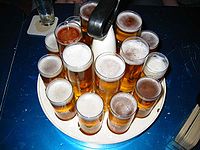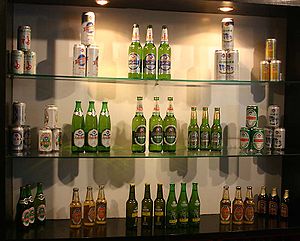- Beer in China
-
See also: Chinese alcoholic beverages
Beer in China (simplified Chinese: 中国啤酒; traditional Chinese: 中國啤酒; pinyin: Zhōngguó píjiǔ) has become increasingly popular in the last century.[citation needed] Chinese beer has also seen a rise in popularity internationally in the last few decades.[citation needed] While most Chinese beers are pale lagers, other styles are occasionally found, such as Tsingtao Dark Beer.
Contents
History
Production and consumption of beer in China has occurred for around nine thousand years, with recent archaeological findings showing that Chinese villagers were brewing beer type alcoholic drinks as far back as 7000 BC on small and individual scales. Made with rice, honey, and grape and hawthorn fruits, this early beer seems to have been produced similarly to that of ancient Egypt and Mesopotamia.[1] Ancient Chinese beer was important in ancestral worship, funeral and other rituals of Xia, Shang and Zhou dynasties, and the beer was called as Lao Li (醪醴 in oracle bone script).[citation needed] However, after the Han Dynasty, Chinese beer faded from prominence in favor of huangjiu, which remained the case for the next two millennia. Modern beer brewing was not introduced into China until the end of 19th century, when Russians established a brewery in Harbin, with another three following (also in Harbin), set up by Germans, Czechoslovaks and Russians respectively.
Brewing ingredients
Chinese beers often contain rice, sorghum and sometimes rye in addition to barley. Interestingly, some beer is produced that uses bitter melon instead of hops as the bittering agent.[citation needed]
Chinese media reported in 2001 that as many as 95% of all Chinese beers contained formaldehyde, to prevent sedimentation in bottles and cans while in storage.[2] This practice has now been made illegal.[citation needed]
Economy
Tsingtao Beer, produced by Tsingtao Brewery, has been the best selling beer in China for eleven consecutive years, and is also the brand most widely exported to other countries, followed by Zhujiang and Yanjing.[citation needed] Tsingtao Beer is brewed in the city of Qingdao (formerly spelled Tsingtao in English) which was a German base in the time of unequal treaties and late-colonial western influence in China. The Germans needed beer for their sailors, soldiers and traders, and production continued after they lost the city to the Japanese in World War I.
Apart from Tsingtao, other major Chinese brewing groups include China Blue Ribbon,[3] Yanjing, Sie-Tang Lio and Zhujiang. Many major international brewers now have interests in, or joint ventures with, Chinese breweries, and popular international brands such as Carlsberg are now produced in China. This gives them access to the Chinese market, while providing capital and expertise to help upgrade local brewing standards, albeit at the cost of variety.[citation needed]
Only a few brewpubs exist in China, primarily in major cities such as Shanghai and Beijing which have a resident western community. The most well-known craft brewer in China is Kaiwei Beer House, a brewpub chain based in Wuhan. There is also Boxing cat brewery in Shanghai.
Since 2011, a few specialty beer delivery services were launched in Shanghai such as Cheers In. They also have beer-only shops in good locations in town.
List of major Chinese beers
Note: This is a partial list of China's major breweries. The vast majority of China's breweries serve only their local vicinity.
- Hangzhou Qiandaohu Beer Co., Ltd. (杭州千岛湖啤酒有限公司) - producer of Cheerday Beer
- Harbin Beer (哈尔滨啤酒)
- Reeb (力波啤酒)
- Snow beer (雪花啤酒)
- Tsingtao Beer (青岛啤酒)
- Yanjing Beer (燕京啤酒)
- Zhujiang Beer (珠江啤酒)
- Wusu Beer (乌苏啤酒) Xinjiang
Hong Kong beers
See also: Beer in Hong KongHong Kong has a large brewery owned by San Miguel Corporation of the Philippines, as well as a microbrewery producing several beers for the local market.
References
- ^ "9,000-Year-Old Beer Re-Created From Chinese Recipe". National Geographic Society. http://news.nationalgeographic.com/news/2005/07/0718_050718_ancientbeer.html.
- ^ "'No trouble brewing,' beer industry insists". China Daily. http://www.chinadaily.com.cn/english/doc/2005-07/14/content_460109.htm. Retrieved 2008-12-08.
- ^ "A blue-collar beer goes upmarket". Danwei. http://www.danwei.org/advertising_and_marketing/pabst_goes_upmarket.php.
External links
- Fermented beverages of pre- and proto-historic China
- Beer-Drinking Etiquette in China[dead link]
- Beer-Drinking Etiquette in China (Archived copy)
 Chinese alcoholic beverages
Chinese alcoholic beveragesBeer in China • Wine in China Beverages Baijiu • Beijing Beer • Canton (liqueur) • Choujiu • Er guo tou • Gouqi jiu • Huangjiu • Kaoliang • Luzhou Laojiao • Maotai • Mijiu • Rice baijiu • Shaoxing wine • Tibetan beer • Wuliangye Yibin • Xifeng jiuIndustry CR Snow • Guangzhou Zhujiang Brewery Group • Tsingtao Brewery • Beijing Yanjing Brewery • Harbin Brewery • Kingway Brewery • Hangzhou Qiandaohu Beer Co., Ltd. • San Miguel Brewery Hong Kong (serving Hainan)Beers of the world Africa 
Asia Europe Americas Oceania Beer and breweries by region · List of countries by beer consumption per capita · Alcohol belts of Europe Categories:- Chinese alcoholic beverages
- Beer and breweries in China
- Industry in China
Wikimedia Foundation. 2010.

